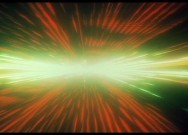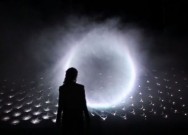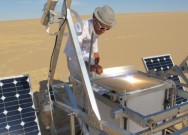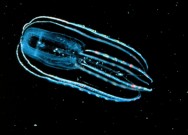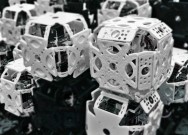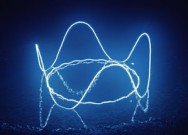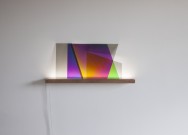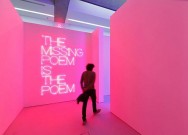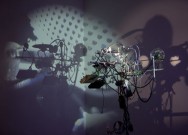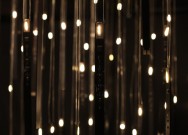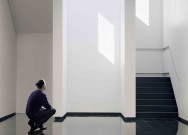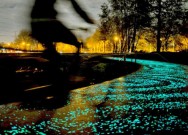2001: Space Odyssey – Stargate Sequenz
Stargate Sequenz
from 2001: Space Odyssey (1968)by Stanley Kubrick
Light Barrier
Light Barrier, 2014
from Mimi Son
Kimchi and Chips create phantoms of light in the air, crossing millions of calibrated beams with their work . The light installation creates floating graphic objects which animate through space as they do through time.
A fascination with natural light drove the technique of the impressionist painters, they explored new qualities of colour and the trail of time. Kimchi and Chips‘ study of digital light discusses a new visual mechanic, their installation adding to the visual language of space and light. As the artist’s inquiry deepens, brush strokes become descriptive like code, detailing reality and allying light with canvas.
Light Barrier was co-commissioned by FutureEverything and the British Council. It premiered at New Media Night Festival, Nikola-Lenivets 4–6 June 2014.
This system creates truly volumetric projections which can define 3 dimensional forms in space, in contrast to ‚hologram‘ screens and fog screens which create planar images.
Solar Sinter Project
Markus Kayser – Solar Sinter Project
In a world increasingly concerned with questions of energy production and raw material shortages, this project explores the potential of desert manufacturing, where energy and material occur in abundance.
In this experiment sunlight and sand are used as raw energy and material to produce glass objects using a 3D printing process, that combines natural energy and material with high-tech production technology.
Solar-sintering aims to raise questions about the future of manufacturing and trigger dreams of the full utilisation of the production potential of the world’s most efficient energy resource – the sun. Whilst not providing definitive answers this experiment aims to provide a point of departure for fresh thinking.
Bioluminiszens
Ambio bioluminescent lamp
by Teresa van Dongen is „a new way to create light“
Dutch designer Teresa van Dongen explains how she created a lamp powered by bioluminescent bacteria usually found on octopuses, in this movie filmed in Eindhoven. Van Dongen’s Ambio lamp, which was her graduation project at Design Academy Eindhoven, consists of a glass tube filled with bioluminescent bacteria in a saltwater solution. The lamp is suspended with the glass tube at one end and a counterbalancing weight at the other. When it is gently rocked the liquid in the tube is mixed with oxygen, causing the bacteria to glow.
Swap streetlights with luminous trees
Daan Roosegaarde
Dutch designer Daan Roosegaarde is exploring ways of using bio-luminescent bacteria found in jellyfish and mushrooms to create glow-in-the-dark trees that could replace street lights.
Dutch designer Daan Roosegaarde is exploring ways of using bio-luminescent bacteria found in jellyfish and mushrooms to create glow-in-the-dark trees that could replace street lights. Roosegaarde’s interest in biomimicry led him to collaborate with the State University of New York and Alexander Krichevsky, whose technology firm Bioglow unveiled genetically modified glow-in-the-dark plants earlier this year.
Krichevsky creates the glowing plants by splicing DNA from luminescent marine bacteria to the chloroplast genome of a common houseplant, so the stem and leaves emit a faint light similar to that produced by fireflies and jellyfish.
Strict regulations around the use of genetically modified plants within the EU mean that Roosegaarde cannot use this material in his Netherlands studio. He had to travel to the US to receive the plant.
Distinct from Studio Roosegaarde’s work with Krichevsky is a second project exploring bio-luminescence, called Glowing Nature, which does not use genetically-modified material. The aim was to find a means of giving mature trees light-emitting properties without harming them, building on research into the properties of bio-luminescent mushrooms.
hypercell – a dynamic system that responds to changes through self-awareness, mobility, softness and reconfigurability
a team of four students: cosku cinkiliç, ahmed shokir, pavlina vardoulaki, houzhe xu in studio theodore spyropoulos assisted by mustafa el sayed developed an architectural system which is dynamic and can respond to changes through self-awareness, mobility, softness and reconfigurability.
HyperCell
is a system based on local decision making between each cell. The system creates continuous forming structures, never in finite form always in formation, changing consistently according to its population. Every individual cell can take its own decisions and has the ability to climb, roll and change its shape according to the system’s needs. Our system will exhibit methods of self-assembly where a number of cells are able to come together without predefined instructions to create meaningful structures. Computational and physical strategies of self-assembly were developed which demonstrate the ability of the single cell and the collective. The system is able to show mobility in two scales, local and global. As an outcome the structure will constantly reconfigure. Through local decision making the system will consciously create space.
Floating Points
Floating Points – Silhouettes (official video)
An oscillating stream of light attempts to intrude on an arid natural landscape, abstract light and a living environment merge, reacting to the dynamics of the music. The luminous abstract forms are produced by a light-painting machine that, frame by frame, draws in a real environment the 3D animated figures. This is an experimental video created by Pablo Barquín, Junior Martínez, Nathan Grimes and Anna Diaz Ortuño.
101.86° Lichtbrechung
101.86°
Puzzling and dazzling, 101.86° offers a new way to experience light. Treated with contemporary methods, the material possesses crystalline qualities that one normally only finds in nature, in the highlands of Iceland. The result is a product of wonder with multi layered colours and a dynamic effect on light.
A collaboration of studio Thomas Vailly & Laura Lynn Jansen
Lichtinstallationen / Lichtkunst / Konzeptkunst und Licht
Olafur Eliasson – Lichtinstallationen
Die Luminale ist ein Festival der Lichtkultur, das seit 2000 alle zwei Jahre in Frankfurt am Main stattfindet. Während des Festivals sind an öffentlichen und privaten Gebäuden sowie an markanten Plätzen in und um Frankfurt Lichtkunstwerke und Lichtinstallationen zu sehen. Wir stellen in unserer Serie sechs Menschen vor, die sich kreativ mit Licht auseinandersetzen.
Maurizio Nannucci – Neon
Seine Lichtinstallationen mit Texten aus Neon zählen weltweit zu den prominentesten Beispielen konzeptueller Kunst. Der Italiener Maurizio Nannucci arbeitet überwiegend mit Neoninstallationen und gestaltet Kunst im öffentlichen Raum.
Mischa Kuball – Konzeptkunst und Licht
In dieser Folge porträtieren wir den 1959 geborenen Düsseldorfer Konzeptkünstler Mischa Kuball. Er zählt zu den international renommiertesten Lichtkünstlern Europas und ist seit 2007 Professor für Medienkunst an der Kunsthochschule für Medien, Köln. Für die Kulturhauptstadt Ruhr 2010 setzt Mischa Kuball Licht als soziales Kommunikationsmittel ein.
Projektionen
RaumZeitPiraten
Die RaumZeitPiraten sind ein Kölner Künstlerkollektiv und fortlaufendes Projekt von Tobias Daemgen, Jan Ehlen und Moritz Ellerich. Seit 2007 arbeiten sie als Gruppe und mit wechselnden Künstlern anderer Ausdrucksformen europaweit. Ihre Aktivitäten sind auf experimentelle Verknüpfungen von Klang, Bild, Objekt, Raum und Zeit ausgerichtet.
Teresa Mar – Projektionskünstlerin
Das Brandenburger Tor, den Fernsehturm oder den Berliner Dom – die Wahrzeichen der deutschen Hauptstadt werden während des „Festival of Lights“ illumiert. Wir begleiten die österreichische Künstlerin Teresa Mar, die unter anderem das Stadtpalais mit abstrakten Collagen bespielen wird. Teresa Mar hat ein internationales Standing und wirkte bereits 2011 und 2012 beim Festival of Lights mit.
Candles in the Wind – Moritz Waldemeyer for Ingo Maurer
Candles in the Wind is a revolutionary new lighting concept, using modern LED technology to faithfully recreate the experience of light from the ancient past – the simple yet infinitely complex candle flame. The design is pure and minimal: a bare circuit board featuring the latest in micro-processor technology paired with 256 high quality LEDs per candle is all it takes to evoke the natural flow and flicker. When seen from a distance, the light is indistinguishable from the real thing, thanks to a perfect match of the light colour of the LEDs. Closer inspection reveals the low resolution charm of the digital display.
Licht und Mode
Der studierte Ingenieur Moritz Waldemeyer arbeitet an der Schnittstelle zwischen Kunst, Design und Technik. Sein Hauptmaterial sind LED-Leuchten. Damit setzt er in einem kleinen Atelier in London Ideen um, die auf internationalen Modeschauen und Design-Messen für Aufsehen sorgen.
Daniel Rybakken – Tageslicht Illusionen
Der Licht-Designer Daniel Rybakken
Ein Norweger zaubert Tageslicht in dunkle Wintertage – und begeistert damit die internationale Designszene. Für Daniel Rybakken bedeutet Licht-Design mehr als schöne Lampenschirme.
Aufgewachsen in Oslo, wo der Winter lang und dunkel ist, interessiert sich Daniel Rybakken schon früh für Licht und dessen Wirkung auf Menschen. Der Norweger erforscht Licht, Schatten, Farbe und Reflexion mit der Neugier eines Künstlers und der Genauigkeit eines Wissenschaftlers. Trotz technischer Komplexität sehen seine Designs immer schlicht und klar aus. Die internationale Designszene ist von Daniel Rybakkens Arbeiten begeistert. Seit fünf Jahren stellt der Licht-Designer seine Werke, bei denen es sich meist um Unikate handelt, in Mailand, London und Paris aus und gewinnt einen Preis nach dem anderen.
Daan Roosegaarde – Lichtkunst auf dem Fahrradweg
Lichtkunst auf dem Fahrradweg
Der niederländische Künstler Daan Roosegaarde hat einen Fahrradweg geschaffen, der in der Dunkelheit leuchtet. Auf dem rund 600 Meter langen Abschnitt haben er und sein Team 50.000 mit fluoreszierender Farbe beschichtete Steinchen eingelassen. Und zwar exakt so, dass bei Dunkelheit ein Wirbelmuster wie auf dem Gemälde „Sternennacht“ von Vincent van Gogh entsteht.
